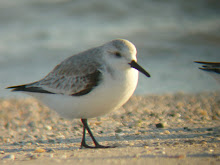The title of this post should explain two news that are going to have a significant impact on the frequency and quality of this blog :
- First and foremost, I am now an happy Dad!!!!! Raphael was born on June 13th, and is obviously the cutest baby of the planet (admittedly, I am strongly biased).
- Second, Raphael managed to be born a week before Father's day, and I received a nice gift, which I had been waiting for, dreaming, anticipating, evaluating for many many months. A new camera!!!!!. The camera is a Panasonic fz28 and has a nice little leica superzoom lens, which will allow me to take some decent pictures of birds for this blog. This is the end of digibining!!!!
Choosing a camera for birding is a tough job, because it is all about compromising. At one end of the spectrum, I was tempted for a while by the DSLR cameras. Their quality is obviously a few steps above any kind of point and shoot camera you can buy, and are wonderfull toys to play with. One the other end of the spectrum, I could pick those nice little superzoom cameras which, in the $300-$400 range, provide a cute little zoom.
At the end, I choose the superzoom camera, for personal reasons :
- First and foremost, the price : An entry level DSLR plus an entry level 300mm zoom are probably about $1000-1500. That's $700-1200 more than a superzoom bridge camera. That's money that could be better used for many many things in a house with a cute little baby. Or maybe two plane tickets to south texas, or florida, for the next vacation (babies travel for free, I was told)
- Second, size and weight. I already carried my son for one hour in one of those cute little kanguru bags. Not too bad, but I was told babies are growing quite fast. I believe I am more likely to bring my camera for traveling and hiking if the camera is light and tiny.
Anyway, I was able to experiment a little bit with my camera during a trip at the sleeping bear national lakeshore. This was a short family trip, and I did not have the chance to do a lot of birding, but still, I enjoyed it
 Sleeping Bear Dunes Landscape
Sleeping Bear Dunes Landscape
Milkweed colonizing the dunes.


Indigo Bunting. The picture was taken about 5-6 meters away (15-18 feet), and I was pretty excited to take my first bird picture with my new camera!

Rose Breasted Grosbeak. My dad spotted first this "funny black and white bird". The bird was 20 m away (60 feet).





4 comments:
Glad your family came over for a visit.
The Sleeping Bear Dunes are so nice, geez - I miss Michigan.
All the very best to the three of you!!
I just discovered your blog after reading Jochen's blog. I too just got a Lumix FZ28 camera as a second camera to take along when my Nikon D300 with 500mm telephoto lens was just too heavy to carry. I haven't quite gotten the hang of it yet in terms of photographing birds, will need a little more practice. I carried that camera when stumbling across an orchard oriole and the photos came out looking terrible... (If you want to see it: July 8 posting on onejackdawbirding.blogspot.com. The bird was much closer when I started shooting, but all other photos came our blurred. I kept this one just for the record)I guess I need more practice. Let me know if you have some special setting that allows you to capture rapidly moving birds.
I think while superzoom lenses have improved greatly in recent years, they still have a number of drawbacks in comparison with shorter-range zooms and prime lenses
Great blog and wonderful photos. Glad to come across a genuine nature lover - a very rare species, these days. Please recheck your Silvery Checkerspot Butterfly, could that be a Painted Lady? I only mention it because you seem to be very thorough about identification. Again, a wonderful website.
J. B.
Post a Comment